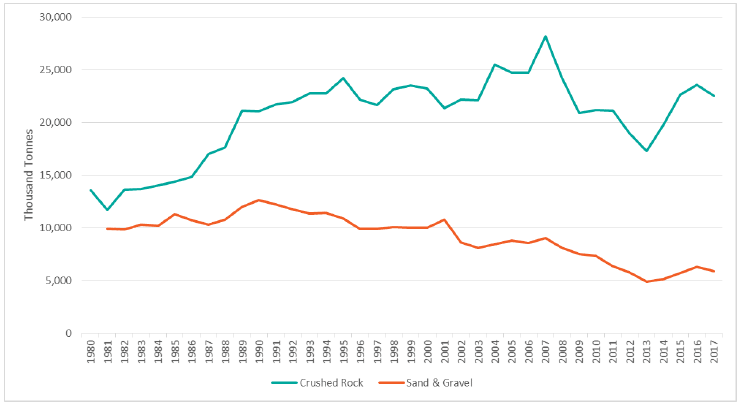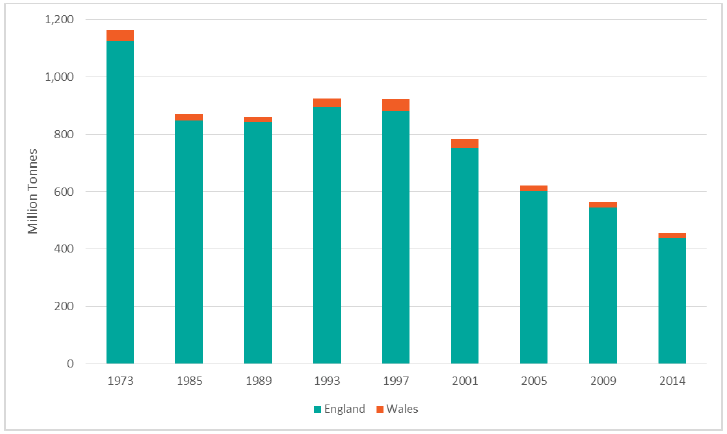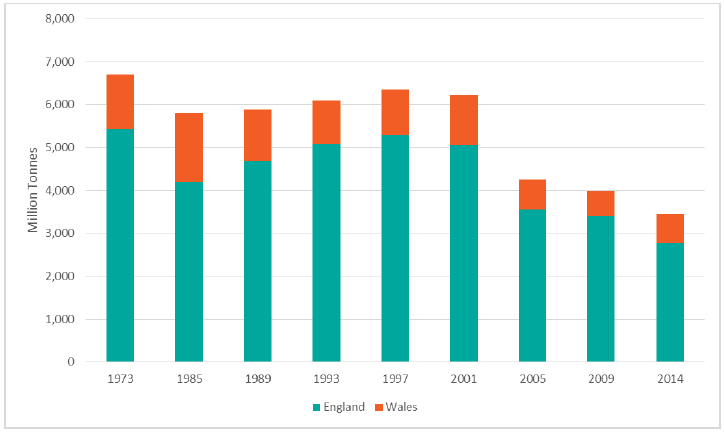Scottish Aggregates Levy: evidence review and policy options
Research reviewing, modelling and analysing illustrative options for a Scottish specific Aggregate Levy.
Analysis of the Scottish Aggregates Market
This section provides an overview of the current production, distribution and reserves of crushed rock and sand and gravel in Scotland. Despite best efforts to find the timeliest data, there are numerous Scottish aggregates data issues that would need to be considered before the design of the tax is implemented.
The primary, official source of data is the Scottish Aggregates Survey, however, the latest survey was conducted in 2012 and published with a considerable lag in 2015. As a result, some of the data is not as current as we would have wished for. In this study, the survey has been supplemented by discussions with the Mineral Products Association (MPA), which represents quarry operators in Scotland, and by the UK Minerals Yearbook, produced by the British Geological Society (BGS). The latest Yearbook was published in 2019 and included data from 2017.[28]
Additional, more timely information (particularly on sand and gravel) has been provided by the Monthly Bulletin of Building Materials and Components published by the UK Government's Department for Business, Energy and Industrial Strategy (BEIS),[29] the ONS Mineral Extraction in Great Britain report, published by the Department for Communities and Local Government[30] and the BGS Minerals Survey for England and Wales.[31] We are restricted in that we do not want to report data for different elements of aggregates for different years. This is why we have had to revert back to the Scottish Aggregates Survey for 2012.
Market Overview
Following an initial study by the Office of Fair Trading (OFT) in 2011,[32] the Competition Commission launched in investigation into the aggregates, cement and ready-mix concrete market. The Competition Commission reported that, across Great Britain, there were 239 aggregates suppliers in 2011. In 2012, five major suppliers accounted for 71% of aggregates sales.[33] This was down from the 73.3% share reported by the OFT for 2009, when one company accounted for nearly 21% of sales.[34]
The five major companies are also present in Scotland, where the Competition Commission additionally named two "mid-tier" suppliers. The precise number of small suppliers in Scotland specifically is not known, however the MPA lists 19 members in Scotland, including the five major companies identified by the Competition Commission.[35] At present, the British Aggregates Association lists 23 members in Scotland, or 19 if members of the MPA are excluded.[36]
The OFT used the concentration ratio (CR5) and the Herfindahl-Hirshman Index to compare the levels of concentration. They found that the CR5 for aggregates in Great Britain increased from around 50% in 1991 to over 70% in 2009. Scotland had a lower rating, having moved from just under 20% to over 50% during this time. This indicates that the market in Scotland may be more diverse than the wider British market, but seemed to be moving in the same direction as the British market as of 2011.
The OFT investigation was partly launched in response to concerns about the level of vertical integration in the market: the five major companies had 90% of the cement market, 75% of the aggregates market and 70% of the ready-mix concrete market. The OFT also noted the high barriers to entry, due to the need for planning permission and physical capital requirements. The OFT had received reports of "vertically integrated firms refusing to supply or discriminating against non-integrated competitors through their pricing". The Competition Commission concluded that the five major companies distributed between 33% and 49% of their aggregates sales to their own downstream businesses. This was lower than the 80-93% for internal sourcing of concrete.
Aggregates Production
Figure 1 illustrates the trends in Scottish aggregates production between 1980 and 2017, with crushed rock production peaking just before the 2008 recession and a general downwards trend in sand and gravel production which appears to have started as long ago as 1990.
The UK Minerals Yearbook 2018 reports that Scotland produced 5.9 million tonnes of sand and gravel in 2017, and 22.5 million tonnes of crushed rock.[37] This compares to 4.5 million tonnes (sand and gravel) and 14 million tonnes (crushed rock) recorded in the 2012 Scottish Aggregates Survey. Thus, depending on the data point, crushed rock is 3-4 times more significant than sand and gravel in tonnage (and levy) terms in Scotland.

Source: BGS (2019) United Kingdom Minerals Yearbook 2018
According to 2012 Scottish Aggregates Survey, more than half of Scotland's sand and gravel comes from West Central Scotland and Tayside & Fife. The former also accounts for nearly a quarter of Scotland's crushed rock, while just under 40% of Scotland's crushed rock is produced in Highland and Moray, predominantly at Glensanda on the west coast of Scotland.
Aggregates Sales
Table 14 (Appendix 6) provides the Scottish regions' sales of sand and gravel in 2019. 5.4 million tonnes were recorded, with West Central Scotland and Tayside & Fife accounting for 61% of the total amount.
The ONS report[38] does not include equivalent sales statistics for crushed rock. However, Table 4 and Table 5 in that report provide a breakdown of sales in 2014 (see Table 15 in Appendix 6). The figures for sand and gravel are broadly consistent with 2019 sales.
Imports
In addition to the aggregates extracted within Scotland, some material is also imported from England and Wales which we refer to as "RUK imports" to distinguish them from "imports from overseas".
These RUK imports mean, combined with the extraction figures in Table 16 (Appendix 6), Scotland's total supply in 2014 was 19.775 million tonnes of crushed rock. In 2014, the ONS reports that 5.111 million tonnes of sand and gravel was sold, meaning the total supply of sand and gravel, including imports, was 5.194 million tonnes.
Thus, it is clear that RUK imports to Scotland of crushed rock represented just 0.1% of the total supply of crushed rock in Scotland in that year and were therefore relatively insignificant. This is because Scotland is essentially self-sufficient in this type of material given the locally-available supply.
In terms sand and gravel, RUK imports totalled 83,000 tonnes (almost exclusively from North West England) in 2014 representing 1.9% of total of supply in Scotland, again suggesting that RUK import penetration of sand and gravel is relatively minor. Again, this is because Scotland mostly produces sufficient sand and gravel for its needs without requiring it from RUK or further afield. It also reflects the relatively high costs of transportation for sand and gravel making long-distance transportation uneconomic.
Exports
Scotland's crushed rock exports to England and Wales (which from now on we refer to as "RUK exports") significantly exceed its imports. According to the 2012 Scottish Aggregates Survey, Scotland exported 5.573 million tonnes of crushed rock to England, compared to the 16,000 tonnes imported i.e. at that point in time Scotland exported 350 times more crushed rock than it imported. The exports originate in Highland & Moray, and represented 30 to 40% of all crushed rock recorded in Scotland that year. Highland and Moray also exported 12,000 tonnes of sand and gravel to England, while SESPlan[39] exported 1,000 tonnes to England. This means that Scotland exported 0.3% of its sand and gravel (13,000 tonnes out of 4.468 million tonnes); sand and gravel imports, shown in Table 16 (Appendix 6), exceed Scotland's sand and gravel exports. Scotland did not directly export aggregates outside Great Britain in 2012 but clearly did (and still does) export significant amounts to RUK (principally from Glensanda) which may or may not have ultimately been exported overseas. This can be seen from UK port statistics which show the tonnage leaving Glensanda (essentially an aggregates-only facility) in recent years has fluctuated around 6 million tonnes per annum.[40]
The 2014 England and Wales survey reported that 3.2 million tonnes of aggregates were imported from Scotland and Europe (notably Norway) to England and Wales, however there is no further breakdown to indicate what proportion of the imports originated in Scotland.[41] As it is known that Scotland exported 5.6 million tonnes to England in 2012, this indicates that Scotland's exports to other parts of Britain declined between 2012 and 2014.
It is clear also that Scottish RUK exports of sand and gravel represented just 0.3% of the total supply of sand and gravel in Scotland in that year and were also relatively insignificant. This is because RUK is essentally self-sufficient in sand and gravel given the readily-available supplies there, as well as the prohibitive transportation costs of moving sand and gravel over long distances across the UK.
Regional Distribution in Scotland
As shown in Table 17 and Table 18 in Appendix 6, the majority of aggregates produced in Scotland are retained within the region in which they are extracted. Highland and Moray is the notable exception, as it only retains 6% of its crushed rock and exports 94% to England, though it is likely that the majority of this is for onward destinations outside the UK following processing at facilities in England. However, for the purposes of the survey, these exports are not counted as exports outside UK.
The destinations of aggregates sold outside the region of origin are shown in Table 19 and Table 20 in Appendix 6. This information is useful for planning purposes and also provides an indication of the degree to which Scottish aggregates are transported around Scotland in response to demand from public infrastructure projects or private commercial and housing-related demand.
Reserves
Table 21 (Appendix 6) shows that the estimated consented reserves[42] of crushed rock in Scotland stood at 533.6 million tonnes in 2012. This was down from 1,367.7 million in 2005, a 61% reduction. 1,227.8 million tonnes of crushed rock were available at active sites in 2005.[43] The 2005 and 2012 reports used slightly different reporting regions, limiting direct comparisons of the reserves in each region. Though these figures provide some context for the level of reserves, they are essentially 8 years old at the time of writing so are therefore will overestimate the current level of reserves of crushed rock.
For sand and gravel, consented reserves were estimated to be 122.8 million tonnes in 2005. Table 22 (Appendix 6), therefore, indicates that 'Estimated Consented Reserves' declined by 32% between 2005 and 2012 to 84.8 million tonnes. It was also estimated that 102.3 million tonnes were available at active sites in 2005, suggesting a 41% reduction in 'Estimated Consented Reserves in Active Sites' to 60.8 million tonnes.[44]
2012 is the latest year for which official data is available. Some local development plans, however, provide an indication of the situation in certain localities. For instance, East Dunbartonshire expects sand and gravel reserves to be constrained after 2021.[45] It is reported that there are sufficient reserves of crushed rock within Glasgow and the Clyde Valley to meet demand until 2035.[46]
As a point of comparison, Figure 2 and Figure 3 show the aggregates reserves in England and Wales. Total reserves of sand and gravel declined by 61% between 1973 and 2014, including a 26% decline between 2005 and 2014. Crushed rock reserves decreased by 49% between 1973 and 2014, with a 19% fall between 2005 and 2014. England and Wales' reduction in crushed rock was less than half the rate of reduction in Scotland over roughly the same period (61%).

Source: BGS (2016) Collation of the Results of the 2014 Aggregate Minerals Survey for England & Wales.

Source: BGS (2016) Collation of the Results of the 2014 Aggregate Minerals Survey for England & Wales.
The MPA reports that, across Great Britain, the ten-year average replenishment rate for sand and gravel reduced to 53% in 2017, compared to 62% in 2016, with newly consented sand and gravel accounting for 24% of sales in 2017. They report that the replenishment rate for crushed rock has reduced "significantly" to 69%, and new permitted reserves represented 3% of sales in 2017.[47]
Price Trends
Figure 4 shows indices of the change in aggregate prices since 2003; the price of crushed rock has increased by 21%, compared to a 50% increase for sand and gravel over the 15 year period.

Source: DBEIS: Monthly Bulletins of Building Materials and Components
Costs
Data on the costs of aggregates extraction (for example, on a per tonne basis) is not generally available for commercial reasons and is likely to vary significantly with the different circumstances, scale and geologies operating in different quarries. However, some information relating to transport costs is available. Interviews with the industry representatives regarding the Aggregates Levy Credit Scheme (ALCS) indicated that it cost 8 pence per tonne per mile to transport aggregates in Northern Ireland when the Aggregates Levy was introduced in 2002. The BGS reported in 2004 that road haulage costs add £6 per tonne to the price of crushed limestone.[48]
As cost is a limiting factor on the distance aggregates are transported, it is worth noting that the average delivery distance for aggregates by road in the UK was 49.8 km (31 miles) in 2013. That year, approximately 10% of aggregates were transported by rail.[49] The MPA reports that 80% of mineral products are used within a 30 mile radius of the quarry, and that 30 million tonnes of quarry products are transported annually outside the road network.[50] These findings support the 2004 report, which concluded that the maximum 'economic' transport distance for aggregates was 60km (37 miles) by road and 200km (124 miles) by rail.[51]
End Use of Aggregates
Across Great Britain, the MPA estimated in 2017 that 30% of aggregates are used in the public sector and 70% in the private sector, following the breakdowns in Table 2. However, as the proportion of public construction in Scotland was higher than the UK average, the MPA concluded that the public sector share of aggregates use in Scotland could be as high as 40%.[52]
| Sector | Public Sector (Million Tonnes) | Private Sector (Million Tonnes) | Total (Million Tonnes) | Share of Public Sector | Share of Private Sector |
|---|---|---|---|---|---|
| New | |||||
| Housing | 6.3 | 35.8 | 42.1 | 15% | 85% |
| Roads | 13.6 | 13.6 | 100% | 0% | |
| Other Infrastructure | 6.9 | 27.7 | 34.6 | 20% | 80% |
| Industrial | N/A | 5.8 | 5.8 | 100% | |
| Commercial | N/A | 39 | 39 | 100% | |
| Non-housing | 13.5 | N/A | 13.5 | 100% | |
| Repair & Maintenance | |||||
| Housing | 2.6 | 9.7 | 12.3 | 21% | 79% |
| Infrastructure | 8.5 | 1.1 | 9.6 | 89% | 11% |
| Other | 1.4 | 4.2 | 5.6 | 25% | 75% |
| Total | 52.8 | 123.3 | 176.1 | 30% | 70% |
Source: MPA
Limitations of the Current Market Analysis
In many cases, the market data is limited because a) the surveys involving a Scottish breakdown of aggregates were conducted several years ago and have been discontinued/not repeated, b) because the information is commercially confidential or c) the surveys did not receive a response. Not having the most up-to-date and comprehensive data on production and consumption means further data will be required to finalise estimates for the amount of total of aggregates produced in Scotland and consumed in Scotland, RUK and the rest of the world. This data could come in the form of a repeat of the Scottish Aggregates Survey last carried out in 2012. It could also come in the form of a Scottish addition to the UK Government surveys of the industry.
This means it is difficult to draw as firm conclusions about the current aggregates market in Scotland, or draw reliable comparisons from past trends, as we would have liked to. However, the evidence indicates that the majority of aggregates, once extracted, are retained for use within their region of extraction. West Central Scotland is a major source of both crushed rock and sand and gravel; Tayside and Fife is also a significant sand and gravel producer, while the Highlands region is the most significant area for crushed rock, though also the biggest exporter of this rock to RUK and/or beyond. More detailed geological research and Scottish-specific data and analysis is needed to provide reliable, up-to-date information on consented reserves.
Contact
Email: robert.souter@gov.scot
There is a problem
Thanks for your feedback